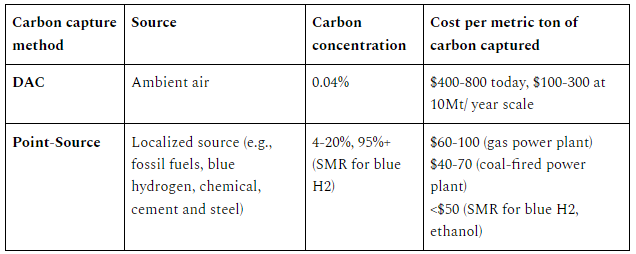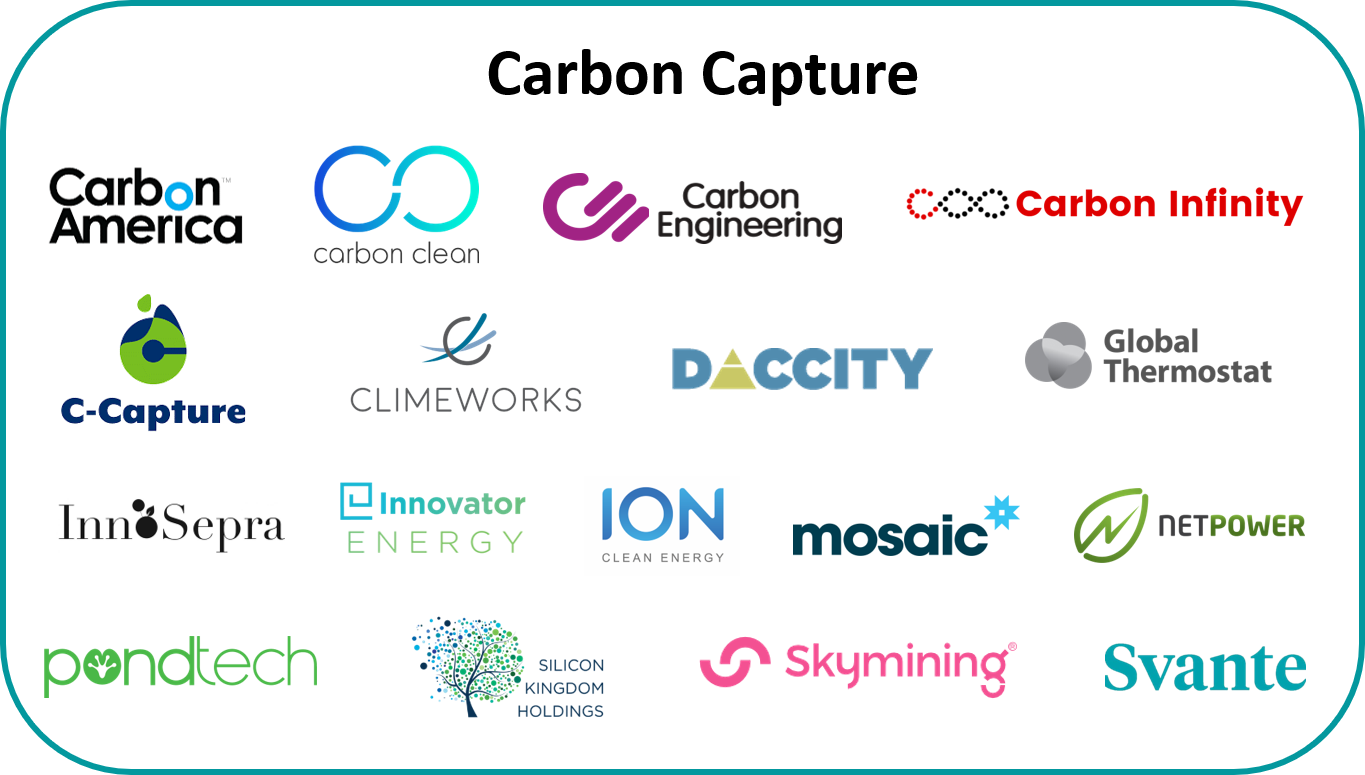
🌎 IMO sets sail for net-zero #242
The International Maritime Organization's first carbon tax ships out
Laying the groundwork for carbon capture and the start to Biden’s climate policy
Happy Monday!
In case you missed it, Elon Musk offered a cool $100m prize to the best carbon capture tech in the market. We’ve made the search easier by mapping the carbon capture startups enabling adoption of CCS at scale. It’s a crowded field with potentially changing economics as technologies mature, but one that is likely to get a lot more attention in today’s shifting regulatory tides.
We also note Biden’s wave of actions as a harbinger of more climate legislation to come, report on big fundings like Rivian and Imperfect, and share a spread of climate jobs.
Thanks for reading!
Not a subscriber yet?
Hours after swearing in as #46, President Biden directed all federal agencies to “immediately review... and take appropriate action to address” Trump-era anti-environmental and public health policies or regulations. The headlines twitterpated over Biden’s swift rejoining of the Paris Agreement and nixing of the Keystone pipeline. It’s easy to get caught up in the fanfare, but these are just some opening moves bringing environmental action to neutral.
Biden is laying the groundwork for more impactful and robust environmental legislative efforts, beyond bringing Trump’s anti-environmental executive orders to heel. By working in partnership across federal agencies, he’s more likely to be effective in crafting lasting legislation that goes beyond term limit dictum.
From the 68 environmental actions so far, the long-term intent is clear:
⛔️ Halting oil & gas leasing in the Arctic National Wildlife Refuge
Read: Stranded assets are fair game in the total energy transition
🚧 Setting new limits on methane emissions, appliance efficiency, and mileage standards
Read: The standards are literally higher, and innovation must be economy-wide
💨 Re-establishing an Obama-era working group on the social cost of carbon
Read: Climate costs will be quantified and incorporated into markets
🚗 Rivian, a Plymouth, MI-based EV startup planning to bring an SUV to market this summer, raised $2.7b from T. Rowe Price Associates, Fidelity, Amazon’s Climate Pledge Fund, Coatue, and D1 Capital Partners. More here.
⚡ Volta, a San Francisco, CA-based EV charging company, raised $125m in Series D funding from Energize Ventures and others. More here.
🍎 Imperfect Foods, a San Francisco, CA-based online food marketplace focused on reducing food waste, raised $95m in Series D funding from Insight Partners and Norwest Venture Partners. More here.
🐟 BlueNalu, a San Diego, CA-based startup producing seafood directly from fish cells, raised $60m in debt financing from Rage Capital, Agronomics, Lewis & Clark AgriFood, and others. More here.
📈 XPansiv, a San Francisco, CA-based market for ESG commodities including RECs, carbon offsets, and differentiated fuels, raised $40m led by Shaw and Partners. More here.
🌲 Arbol, a New York, NY-based weather-based insurer, raised $7m in Series A funding from Finch Finance, Space Capital, and Mubadala Capital-Ventures. More here.
⚡ Ekona Power, a Vancouver, Canada-based developer of hydrogen technology, raised $3m from BDC Capital. More here.
🔋 e-Zinc, a Toronto, Canada-based energy storage innovator, raised $2m from BDC Capital. More here.
EVgo, a Los Angeles, CA-based operator of EV charging stations, agreed to go public via reverse merger with David Crane’s SPAC Climate Change Crisis Real Impact I, valuing EVGO at around $2.6b. [Check out our feature with David Crane back in October] More here.
Shoals Technologies Group, a Portland, TN-based provider of solar balance-of-systems solutions, is going the traditional route announcing plans to IPO. More here.
Breakthrough Energy Ventures, has raised $1B(!) for its second fund targeting startups with deep decarbonization potential. More here.
Blue Horizon Ventures, a Zurich-based sustainable food technology focused venture capital fund, raised $222m for its flagship fund. More here.
Last week the world’s richest person, aka Elon Musk, threw down the gauntlet on Twitter, announcing a $100m prize for carbon capture tech. To support Elon on his hunt, and to help the rest of us frame up this notoriously misunderstood market, we went to the start of Carbon Capture, Utilization, and Storage (CCUS) to explore the capture - as an addendum to our prior review of utilization or carbon to value.
At 417ppm CO2 concentration levels, we’ve moved on from targeting carbon neutral to carbon negative. Despite the UNFCCC’s frantic message that we must scale up significant carbon capture in order to reduce existing atmospheric CO2, CCS commercialization is in early innings, plagued by a lack of financial and regulatory incentives, high price tags, and clunky large-scale deployment. There are currently 26 commercial CCS facilities mopping up ~40M captured CO2 tonnes per year, primarily via EOR (enhanced oil recovery). To put this in perspective, there’s a veritable lake of 10 to 15 gigatons or 10,000M to 15,000M CO2 tonnes per year that needs to be removed by 2050 just to keep below two degrees!
Fortunately, buoyed by the expanded federal 45Q tax credit and recent stimulus bill incentives, the clean up crew reinforcements are beginning to arrive. 45Q carbon credits are going for $50 per sequestered ton, more than double a decade ago. “There’s more and more federal funding to support R&D for a huge pipeline of earlier stage innovations with enormous potential. We’re just at the very beginning,” comments Noah Deich of Carbon180, the premier carbon removal NGO.
Recent corporate action has also marked the dawn of the carbon removal age. Notably, Microsoft, Amazon, Stripe, Shopify, and other tech giants have cumulatively committed to invest +$3b in carbon negative companies and projects. Outside of Silicon Valley, Occidental Petroleum and United Airlines joined 1PointFive to make essential DAC infrastructure, including engineering the world’s largest DAC plant in Texas to capture 1M tons of CO2 annually.

Carbon capture approaches bifurcate into DAC (direct air capture) where carbon is captured from the ambient air or Point-source capture from a localized, industrial site. Logically, point-source beats DAC in economic efficiency given the lower capture costs from higher CO2 concentrations. Compared to a coal plant’s point source emissions, DAC projects require ~300x greater contact area to capture the same volume of CO2.
CCS projects are applying the renewable energy development playbook:
💳 Project developers finance the project
⛏️ Carbon capture startups supply the technologies
👷 EPCs (engineering, procurement and construction companies) build the plant
💰 Customers commit to buy removal supply
🛒 End-users offtake the CO2
CO2 end-users either apply it to utilization (e.g. fuels, diamonds, etc.) or storage (e.g. EOR, mineralization, etc.). Government incentives like tax credits (45Q, LCFS) and a price on carbon expedite market forces. Similarly, courageous corporate buyers have started to put their money where their mouths are to seed demand for first of a kind (FOAK) projects.

Within this “Air Mining” value chain, startup activity is most active in developing the pickaxe technology and materials which can significantly improve the economics of CCS projects. Leading technologies capture carbon through liquid solvents or solid sorbents which act as capture agents that bind with CO2 in air/ gas flows. Liquid solvents are most mature (repurposed from their prior O&G applications) with novel startups starting to employ solid sorbent technologies. We talked to Carbon Engineering, Svante, Carbon Clean, and Mosaic Materials here about how they’re pushing the boundaries of capture technologies and ratcheting down costs.
For more resources on carbon capture, check out the excellent CDR Primer, Prime Movers Lab’s 5-part Medium posts, and Stripe’s Ryan Orbuch insights. Next week, we’ll address nature-based solutions to carbon capture through a deep dive into the soil carbon market.
Janet Yellen, the Treasury secretary nominee and former Fed chair, pledged to create a team focused on examining the financial risks that climate change poses. We’re excited for where this goes.
Tesla has reportedly started delivering locally made Model Y crossovers in China, marking another milestone for the electric carmaker. In order to reach its ambitious 20m by 2030 sales target, it’s vital that Tesla cracks the world’s largest vehicle market.
Swell Energy will establish a $25m virtual power plant in Hawaii to deploy behind-the-meter batteries to ~6,000 residential customers.
Nel announced it will slash electrolyzer costs by 75% at its new 2GW factory as a major step towards bringing green hydrogen (from renewables) to cost parity with grey hydrogen (from fossil fuels) by 2025.
Total is the first oil major to leave the American Petroleum Institute, the infamous fossil fuel lobbying group, over disagreement on APIs climate position (or lack thereof).
The world invested a record-breaking $500bn in 2020 in the clean energy transition (renewables, EVs, electrification) according to BNEF’s new report.
Bloomberg raises concerns about EV SPACs’ ability to implement their business plans, as we highlighted last week.
Is China a global power, or is China powering the globe? Check out Boston University’s interactive map of Chinese foreign direct investment in renewables.
Riding the rising tide of demand for climate tech data, Pitchbook ramps up its coverage with a new climate tech glossary.
An MIT study found that ecommerce was more sustainable than traditional retail in 75% of modeled scenarios because of… retail’s high transport-level emissions!
Play around with this very neat customizable tool (also from MIT) to compare the long-term climate and financial scenario of your EV vs ICE car purchase. (Spoiler: EVs are better, generally).
As Project Loon deflates its internet balloons after their last flight, the team at Alphabet’s Project X thoughtfully penned a letter about a case study on the challenges and learnings from hardtech, well, loonshots.
💡 BloombergNEF Pioneers: Startups, pilot projects, and other organizations working to reduce greenhouse gas emissions can apply to BloombergNEF's annual climate-tech innovation competition. Applications are open until February 19th.
💡 On Deck Climate Tech Fellowship: Join the inaugural cohort starting on March 6th for a 10 week bootcamp to help you broaden your network across the climate tech ecosystem. FAQs with more information, and a reminder that they offer a needs-based scholarship.
Thematic Investing Research Analyst @Global X
Energy Modeler, Consultant @E3
Senior Policy Advisor @Elemental Excelerator
Ventures Associate @Anthesis Ventures
Program Director @New Lab
Sales Development Representative @ChargeLab
Technology and Public Purpose Fellowship @Harvard
Thermal Mechanical Design Engineer, Plasma Physicist, and more roles @Modern Electron
Data Scientist, Software Engineer @eIQ Mobility
Feel free to send us new ideas, recent fundings, or general curiosities. Have a great week ahead!

The International Maritime Organization's first carbon tax ships out

Trump’s coal push ignores economic reality and attractive alternatives

The tariffs' toll, explained sector-by-sector